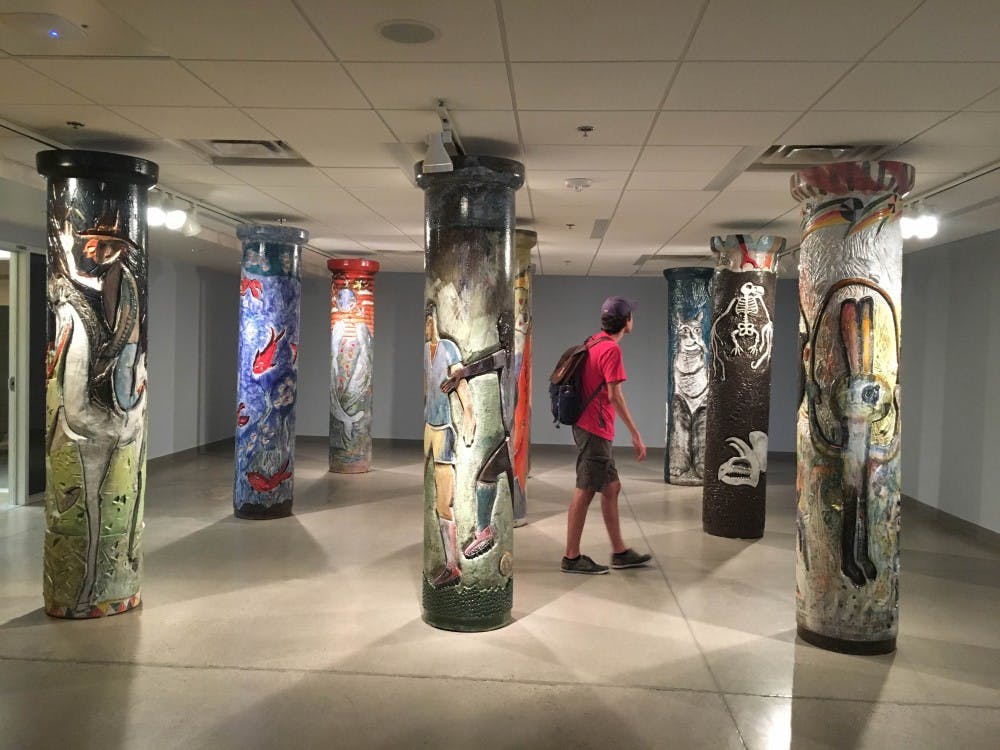Whether in ancient Greek pottery or the movie Ghost, clay is an important part of cultural history.
“Pipe Brothers,” an exhibition at ASU featuring work from actor James Franco and his brother Tom, highlights clay's cultural significance. The show, which runs until Sept. 23, wouldn't be possible without Mission Clay Arts and Industry, which helped the brothers create nine carved and painted clay pillars and install them at the ASU Art Museum Ceramics Research Center.
Mission Clay Arts and Industry is an offshoot of Mission Clay Products, a California clay sewer pipe supplier. The company has manufactured pipes since 1950 and began its artistic endeavors in 1979, according to the company's site. Bryan Vansell, the founder of Mission Clay, said that the process of creating these pipes is intriguing to people.
“Clay is practically the most natural product on earth, and plastic is a very nauseous toxic product,” he said. "But they can serve the same purpose."
For Vansell, that purpose is to make pipes. But he said clay has several advantages over materials like plastic.
“It’s the greenest product on the planet: We take clay, we add water and we add heat,” Vansell said. “It’s the most sustainable product in the industry, and it's a beautiful product.”
Brandi Lee Cooper, an ASU ceramics graduate student and intern with Mission Clay, said that actually seeing clay be mined and dug up into huge mounds is inspirational. The fact that it all happens here in Arizona makes it all the more personal for these artists.
“We are getting to work with people who really respect the field,” Cooper said.
The show is fitting, as Cooper said an important aspect of the clay culture is the collaboration. And from an artistic perspective, being able to see clay at such a large scale is intriguing, she said.
“ASU is number one in innovation for a reason," said Garth Johnson, the curator of ceramics for the ASU Art Museum.
He said that ASU's ceramics program is unique because the Herberger Institute for Design and the Arts is interdisciplinary. This allows students to make lasting connections, Johnson said.
For students who are not majoring in fine arts, clay's “improvisational tendencies” allows for someone who doesn’t know precise techniques to still create something, Johnson said. Many artists embrace that aspect of clay, and base their art around that improvisation.
Johnson has worked with Tom Franco since the artist came to Arizona for the project. James Franco collaborated as well, creating his own 7-and-a-half foot clay pipes.
“Working with the Francos has been incredible," Johnson said. "It's nonstop creativity, and they don’t see boundaries to their creativity or borders. They’re both intense workaholics.”
The Arizona heat — the only reason Mission Clay Arts and Industry isn't open to artists year round — was a minor obstacle. But the Franco brothers prevailed.
“I was really struck by (Tom Franco's) efforts at community building and his curiosity,” Johnson said. “Ceramics is an incredible tool for lifelong learners to be able to learn something about their personalities. Ceramics is a part of our society.”
Reach the reporter at stefany.marquez@asu.edu or follow @stefmarz on Twitter.
Like The State Press on Facebook and follow @statepress on Twitter.




